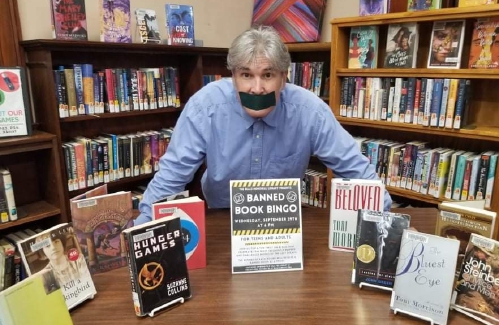The opening of Tariq Ali’s historical novel Shadows of the Pomegranate Tree, set in Spain during the Reconquista, describes Christian soldiers, acting on orders of Cardinal Ximénezde Cisneros, head of the Spanish Inquisition, storming the libraries and houses of Moorish Grenada.
They seize approximately 5,000 irreplaceable philosophical and theological works and toss them (medical manuscripts were exempt) into a huge bonfire in Grenada’s center as residents, tears streaming down their faces, are forced to watch.
From Judah’s King Jehoiakim who burned a scroll written by prophet Jeremiah, to Roman Catholic Emperor Jovian reducing the Library of Antioch to ashes, to the library at Nalanda, India, a vast repository of Buddhist learning, incinerated by Muslims, to Nazis torching “un-German” books on Berlin’s Opernplatz, to Harry Potter books going up in flames in New Mexico because they were believed, by the arsonists, to encourage satanism, book burning’s been an anti-intellectual plague for millennia.
Book burning isn’t exclusive to any specific ideology. Over centuries too many have succumbed to supremacist impulses — left, right, authoritarian, anarchist — all attempting to extinguish the humanity, religion and culture of peoples who don’t look or think like them.
The first book burning in our Thirteen Colonies was in 1651 when Puritans banned and torched a book critical of puritanical Calvinism, The Meritorious Price of Our Redemption, and tried its author, William Pynchon, for heresy.
Today, in America, ongoing right-wing attempts to invisibilize the Other as part of a project to disenfranchise and marginalize communities of color includes attempting to censure and ban books and artwork which challenge white entrenched supremacist narratives.
Today’s anti-intellectual zealots have more sophisticated weapons than matches.
Together they rant on social media and write dog-whistling letters to the editor. They organize as “concerned” parents and citizens and band together to either run for local school boards or join forces to confront and intimidate school board volunteers who won’t do their bidding. Together they seemingly believe that the primary purpose of education is to make people who believe as they do feel good about themselves.
Together they want to limit what schoolchildren are taught.
People who bemoan the retirement of Aunt Jemima, Native American mascots, and six Dr. Seuss books would rather ban The Hate U Give, Captain Underpants, Stamped from the Beginning and Nobel Laureate Toni Morrison’s Beloved than have their children learn about slavery, Ahmaud Arbery, lynchings, Tulsa, George Floyd, red-lining, all-white country clubs, MS St. Louis, the genocide of Indigenous peoples, systemic racism, Medgar Evers, Jim Crow and voter suppression.
Today they’re so determined to remain the exclusive narrators of America’s history that they appear willing to do anything to retain power, willing even to intimidate school administrators into censoring student art projects.
This week a letter published in The Portsmouth Herald criticized a York, Maine high schooler for creating an art project inspired by a young adult book she read called A Very Large Expanse of Sea, by Tahereh Mafi.
Its author wrote, “The [report] about the student at York High School and her art project should serve as an illustration of how Critical Race Theory is actually being presented in schools. It was very sad to see a young lady presenting her country in such a negative light … And it all started with a book she read in English class about an immigrant child and her struggles with racism.”
The letter writer misrepresented both CRT, a decades-old form of legal analysis that argues race is a social construct, not just the result of individual prejudice, and the student’s work.
The artist did not present her country in a negative light, she reflected the truth of a nation struggling to confront elements of racism and exclusion that persist in our Public Square. The teenager was inspired to do what true patriots are called to do: confront injustice.
The book she read isn’t about an immigrant child. It’s about a native-born American who struggles with racism, identity, and a boyfriend, all neither new nor uncommon experiences for our children, especially those of color.
I, too, have read A Very Large Expanse of Sea. It’s a powerful coming-of-age story about Shirin, a hijab-wearing, 16-year-old Muslim high-school sophomore in post-9/11 America who tells her Global Perspectives teacher:
“I’m tired as hell, Mr. Jordan… I’ve been trying to educate people for years and it’s exhausting. I’m tired of being patient with bigots. I’m tired of trying to explain why I don’t deserve to be treated like a piece of shit all the time. I’m tired of begging everyone to understand that people of color aren’t all the same, that we don’t all believe the same things or feel the same things or experience the world the same way… I’m just—I’m sick and tired of trying to explain to the world why racism is bad, okay? Why is that my job?”
We should all be sick and tired of it.
Racism persists because there are communities in our midst who would rather indoctrinate children with parochial fears and prejudices of the Other than educate them to embrace the richness and beauty of a diverse, pluralistic world.
What’s at stake today is whether America will be defined by privilege or prejudice, history or hysteria, knowledge or ignorance. By an embrace of the promise of America or by fear of the Other.
Shirin says she told a friend that “…the bigots and the racists had always been there, and he said he’d honestly never seen them like this, that he never thought they could be like this, and I said yes, I know. I said that’s how privilege works.”
That’s how white privilege works.
(Robert Azzi is a photographer and writer who lives in Exeter. His columns are archived at theotherazzi.wordpress.com.)
Credit: Source link



